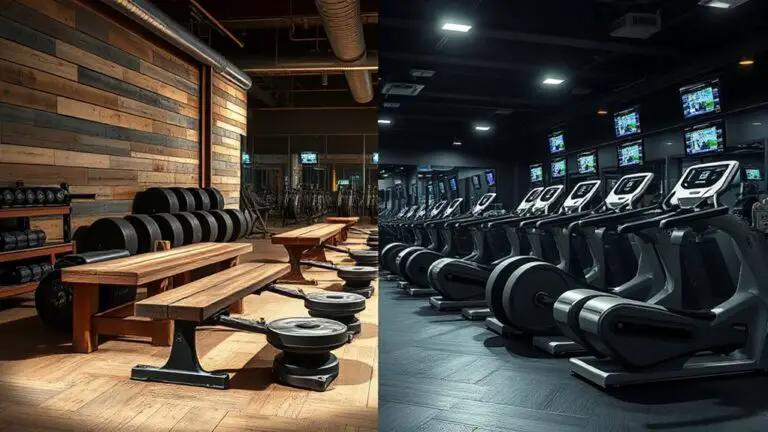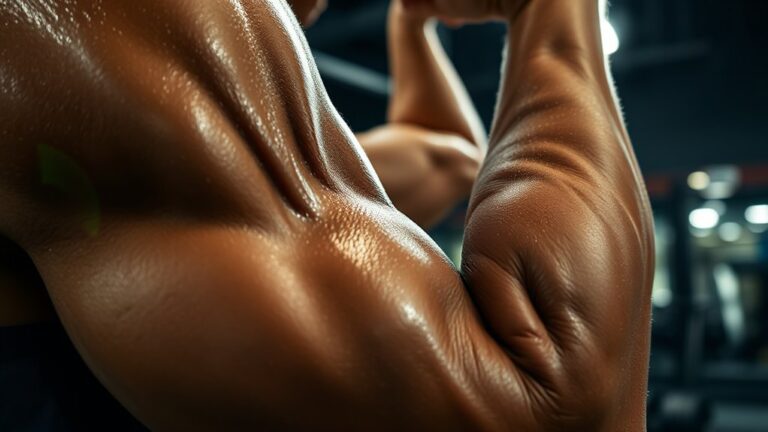The Science Behind Pump Workouts From the 70S & 80S

The science behind pump workouts from the 70s and 80s revolves around high-repetition training that boosts blood flow to your muscles, creating a temporary swelling effect known as the “pump.” This increased blood delivery leads to micro-tears in muscle fibers, triggering growth and repair mechanisms. By focusing on higher reps with lighter weights, these workouts enhance muscle endurance and sculpt specific muscle groups. There’s much more to explore about the evolution of pump techniques and their current applications.
Understanding the Pump Effect: What Happens to Your Muscles

When you engage in a pump workout, your muscles undergo a fascinating physiological response primarily driven by increased blood flow. As you perform high-repetition exercises, your body directs more blood to your working muscles, causing them to swell temporarily. This surge in blood flow enhances the delivery of oxygen and nutrients, essential for muscle physiology.
During this process, your muscle fibers experience micro-tears, which, coupled with the increased blood supply, signal your body to initiate repair mechanisms. This not only aids in recovery but also promotes muscle growth over time. Additionally, the accumulation of metabolites, such as lactate, contributes to the sensation of the pump, reinforcing the effectiveness of your workout. To ensure you are making progress, it’s crucial to set realistic goals and consistently evaluate your workout effectiveness to optimize your training strategy.
Understanding this interplay between blood flow and muscle function can help you optimize your training strategy, ensuring that you harness the full benefits of the pump effect during your workouts.
The Role of Repetitions and Weights in Pump Workouts
While the choice of weights and repetitions might seem straightforward, it plays a vital role in achieving the desired pump effect during workouts. In pump training, you’ll typically focus on higher repetition ranges—usually between 8 to 15 reps. This approach encourages blood flow to your muscles, enhancing that coveted pump.
When it comes to weight selection, it’s essential to strike a balance. You want to choose a weight that allows you to complete your desired repetitions while still pushing your limits. Lighter weights with higher reps can lead to increased muscle endurance and vascularity, important for achieving that pumped look.
Conversely, if the weight is too heavy, you risk sacrificing form and reducing the overall effectiveness of your workout. As a result, thoughtful weight selection combined with appropriate repetition ranges is vital for maximizing the pump effect and ensuring your muscles respond effectively to the training stimulus.
Hypertrophy and Endurance: The Benefits of High-Rep Training

High-repetition training offers unique benefits for both hypertrophy and endurance, making it an essential component of effective pump workouts. When you focus on higher rep ranges, typically between 12 to 20 repetitions, you create a metabolic environment conducive to muscle growth. This approach increases time under tension, which stimulates muscle fibers and enhances the hypertrophic response.
Moreover, high-rep training promotes muscular endurance by conditioning your muscles to sustain prolonged activity. With consistent practice, you’ll notice improved stamina, which translates to better performance in both weightlifting and daily activities.
While the training intensity may be lower than heavy lifting, the cumulative effects of high-rep sets lead to significant muscle adaptations. Ultimately, integrating high-rep workouts into your routine not only enhances your aesthetic goals but also builds a solid foundation for overall fitness. By embracing this method, you can experience extensive benefits that extend beyond the gym.
Iconic Pump Workout Routines From the 70S and 80S
The popularity of high-rep training in the 70s and 80s gave rise to a variety of iconic pump workout routines that defined the era’s fitness culture. These classic bodybuilding sessions weren’t just about lifting weights; they were about the experience of retro fitness, where the focus was on achieving that coveted “pump.” Here’s what made these routines unforgettable:
- High-volume sets that left muscles burning and users exhilarated.
- Supersets and drop sets for maximizing intensity and engagement.
- Isolation exercises that sculpted each muscle group with precision.
- Dynamic warm-ups to prepare the body for rigorous activity.
- Community-driven environments, fostering camaraderie and motivation.
Each of these elements contributed to a workout that not only built strength but also created a sense of belonging among fitness enthusiasts. These routines still resonate today, reminding you of the passion that defined an era. Engaging in progressive overload is essential for building muscle effectively, just as these workouts emphasized pushing limits.
Modern Applications: How to Incorporate Pump Workouts Today

To effectively incorporate pump workouts into your modern fitness routine, it’s essential to adapt the principles of the past to suit today’s training methodologies. Begin by integrating circuit training, which allows you to maintain a high heart rate while performing multiple exercises. This approach maximizes muscle engagement and enhances the “pump” effect. Select compound movements like squats, bench presses, and rows, ensuring you include lighter weights and higher repetitions to promote blood flow and muscle endurance.
Additionally, prioritize recovery techniques between circuits. Incorporate active rest periods using dynamic stretches or light cardio to keep your muscles engaged without sacrificing recovery. Hydration and nutrition play pivotal roles in this process, so consider pre- and post-workout snacks rich in protein and carbohydrates. By blending these elements, you’ll not only experience the nostalgic benefits of pump workouts but also align them with contemporary fitness strategies for peak results. Skipping rope can also be a great addition to your routine, providing effective cardio benefits while enhancing muscle tone and endurance.
Frequently Asked Questions
What Are the Origins of Pump Workouts in Fitness History?
You might think pump workouts are just a modern trend, but their origins trace back to a fascinating evolution in bodybuilding. In the 70s and 80s, influencers like Arnold Schwarzenegger popularized techniques that emphasized muscle hypertrophy. The aerobic influence during this period also encouraged lighter weights with higher repetitions, creating that signature “pump” feeling. This blend of techniques laid the foundation for today’s fitness routines, showcasing a unique intersection between strength training and endurance.
How Did 70S and 80S Culture Influence Pump Workout Popularity?
The 70s and 80s culture, with its vibrant disco aesthetics and emerging fitness icons, played a vital role in popularizing pump workouts. You’d find people drawn to gyms that mirrored the lively, energetic atmosphere of disco clubs. Icons like Jane Fonda and Arnold Schwarzenegger showcased these workouts, blending fitness with fun. This connection between exercise and cultural trends made pump workouts not just a fitness routine, but a lifestyle that celebrated health and self-expression.
Are Pump Workouts Suitable for Beginners?
Yes, pump workouts can be suitable for beginners, especially with beginner modifications. You can adjust the workout intensity by using lighter weights and focusing on proper form, which helps prevent injuries. Incorporating high-rep sets allows you to build endurance without overwhelming yourself. It’s vital to listen to your body and gradually increase intensity as you become more comfortable. This way, you can enjoy the benefits of pump workouts while ensuring a safe experience.
What Equipment Is Typically Used in Classic Pump Workouts?
When it comes to classic pump workouts, you might’ve heard the saying, “What you put in is what you get out.” Typically, you’ll find equipment like dumbbell curls and resistance bands at the forefront. Dumbbell curls help target your biceps for that coveted pump, while resistance bands offer versatility, allowing for various exercises that engage multiple muscle groups. Together, they create a balanced routine that’s effective for building strength and endurance.
How Do Nutrition and Hydration Impact Pump Workout Results?
Your nutrition and hydration play essential roles in pump workout results. By focusing on nutrient timing, you can optimize muscle recovery and growth. Consuming protein and carbs pre- and post-workout fuels your performance and aids muscle repair. Additionally, effective hydration strategies guarantee you maintain peak performance and prevent fatigue. Staying adequately hydrated helps maintain blood volume, enhancing the pump you feel during workouts. Pay attention to these factors for better results.





